
River flows better than expected in spite of ‘severe drought’ listing
By Michael Howell
Despite the recent “Severe Drought” declaration in Ravalli County, the water flows in the Bitterroot River are doing “better than expected,” according to local officials who are keeping close tabs on the situation. Better than expected, but not necessarily up to par. But it is a far cry from the crisis that was looming earlier this summer.
According to Fish, Wildlife and Parks (FWP) Bitterroot Fisheries Biologist Chris Clancy, the most critical place for water flows in the Bitterroot River is at Bell Crossing. All the major ditches in the valley have pretty much taken out their water above that point and much of it will not return to the river until down around the Stevensville area.
It was the drying up of that stretch of the river that led to the purchase by FWP of 50,000 acre feet of water out of Painted Rocks Reservoir to release in the low water times to supplement the flows at Bell Crossing. A minimum flow of 400 cubic feet per second at Bell Crossing was identified as a goal for maintaining a healthy fishery. But that goal is not always met.
“In really dry years the flow there can get below 200 cfs,” said Clancy. “This year, right now, it’s at 315 cfs.”
Clancy said that it was recognized from the beginning that the goal was not going to be attainable but, working with Bitterroot River Water Commissioner and damtender Al Pernichele, who parcels out water to the irrigators, the two of them try to keep it between 250 to 300 plus cfs.
This year they are doing okay, but a couple of years ago dead fish were seen floating in the river, primarily due to low flows and associated warm water temperatures.
As for releasing Painted Rocks water for the fisheries, it does a lot of good but it is no silver bullet.
“We try to be logical with the Painted Rocks releases,” said Clancy, “but a lot of things are happening up and down the river in terms of headgates and there is also the unpredictable nature of the weather.”
This July things looked pretty bleak. For the second year in a row we had a low snow pack, an early melt and a hot dry month. Then came the scare at Bell Crossing. That is, the incredible low water flows being reported on the USGS website for the Bell Crossing gauge. Down to 150 cfs!
This baffled Pernichele. He couldn’t figure it out. He had set all the headgates and determined that at there should be 250 to 300 cfs at Bell Crossing. It turned out that when a river shifts course it can change the readings on the gauge which is based on both depth and flow which are calculated on a “rating curve.” Shifts in the river can skew the rating curve. This one was off by 110 to 120 cfs and the rating curve was recalculated. That was remedied by August 3, but it did get everyone’s attention to a situation that could very easily go bad.
Since FWP’s water from the reservoir is limited, Clancy said he works with Pernichele to release it incrementally, trying to maintain a low but satisfactory flow for the long term rather than a good flow that ends too early leaving the river dry.
Pernichele points out that nobody wants fish to die and the irrigators have been very generous in cutting back on their own use when the crunch really comes.
Both Pernichele and Clancy believe that things could easily have been much worse if we had not gotten this latest spell of wetter weather and milder temperatures.
Another player in the game at keeping the water flowing for the fishery at Bell Crossing is the Bitter Root Irrigation District. BRID does not take water from the Bitterroot River or from the tributaries, according to BRID manager John Crowley. All the water they use, except for a few exceptions, comes from the Lake Como dam. The dam also stores water for FWP that is released incrementally, usually at the end of the season. About 3,000 acre feet of water is generally released at the rate of about 50 cfs per day for about 30 days.
“It’s not a lot of water,” said Crowley, “but it helps a little bit to keep the river a little cooler and flowing a little more.”
Crowley said that this year it looks like the irrigation water will run until Labor Day and that’s about normal. He said the shortest irrigation season on record was in 1992 when they shut the ditch down on August 12.